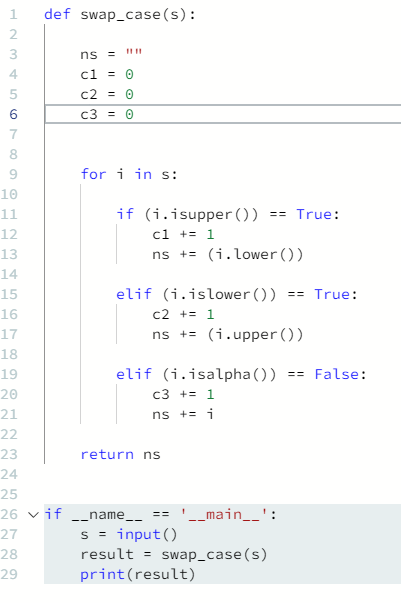Publish Date - February 8th, 2023
|Last Modified - May 11th, 2023
This solution was fun to solve. It has it all, loops, conditionals, string manipulation, variables and functions. While you may be able to use the function swapcase(), I think it’s a great way to show Jr. Python developers how to mix everything together! While it was harder than the Tuple’s solution and easier than runner up score it doesn’t hold a light at all to some of the MySQL challenges in terms of complexity. Let’s jump into the problem and solution as always:
The problem
You are given a string and your task is to swap cases. In other words, convert all lowercase letters to uppercase letters and vice versa.
For Example:
Www.HackerRank.com → wWW.hACKERrANK.COM
Pythonist 2 → pYTHONIST 2
Function Description
Complete the swap_case function in the editor below.
swap_case has the following parameters:
- string s: the string to modify
Returns
- string: the modified string
Input Format
A single line containing a string .
Constraints
0 <= len(s) <= 1000
Sample Input 0
HackerRank.com presents "Pythonist 2".
Sample Output 0 (Is your desired output).
hACKERrANK.COM PRESENTS "pYTHONIST 2".
The solution
def swap_case(s):
ns = ""
c1 = 0
c2 = 0
c3 = 0
for i in s:
if (i.isupper()) == True:
c1 += 1
ns += (i.lower())
elif (i.islower()) == True:
c2 += 1
ns += (i.upper())
elif (i.isalpha()) == False:
c3 += 1
ns += i
return ns
if __name__ == '__main__':
s = input()
result = swap_case(s)
print(result)There’s multiple layers for my solution, so I’ll break it down and summarize everything together.
If I were to write this out from a logic standpoint it would be like this:
There’s a function (swap_case) that does the following:
- set an empty “new string” with three other variables as generic counters (c1, c2, c3)
- loop through “s” individual with “i” (so each letter of “s” which is HackerRank.com presents “Pythonist 2”.)
- and then each IF clause:
- if “i” (which is a letter, number or non-alpha) is uppercase, count each one and assign each uppercase letter as a lower case letter to the new string.
- if “i” (which is a letter, number or non-alpha) is lowercase, count each one and assign each lowercase letter as a lower uppercase to the new string.
- if “i” (which is a letter, number or non-alpha) is not an alphanumeric, count each one and assign it to the new string. Note: that I didn’t change the non-alphanumeric).
- Next, I return “ns” (new string) so that it can be passed in the following “result”, when the user input’s something (s).
Your final output:
hACKERrANK.COM PRESENTS "pYTHONIST 2".Some custom input and outputs:
Input: tHERE wAS aCOOL pERSON tHAT wAS vERY sMART
Output: There Was Acool Person That Was Very Smart
Input: mACHINE lEARNING iS vERY cOOL
Output: Machine Learning Is Very Cool
Input: i LoVe NaTuRaL LaNgUaGe PrOcEsSiNg
Output: I lOvE nAtUrAl lAnGuAgE pRoCeSsInG
Conclusion
Like I said, this is one of my favorite Python examples to date. It gives you a little bit of everything and actually has some genuine use cases. You could use this as a script to title case all the content on a webpage or title-tags across a website. Web development concepts aside, there are plenty of other applications to shape a function like this. I hope this article helped you solve a fun question!
